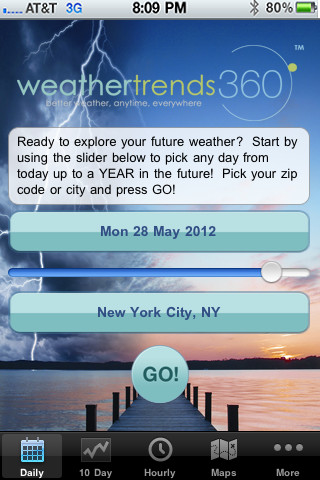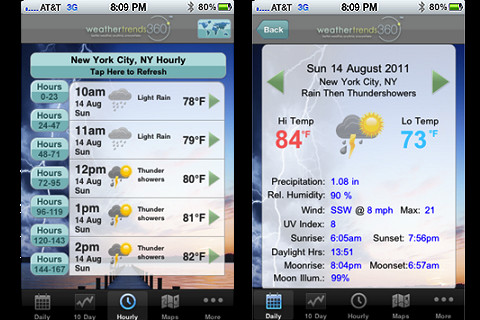My local news station weatherman seems to have a 50/50 success rating predicting the 5 day forecast. Imagine my surprise when I learned about a company called Weather Trends International that claims to provide weather prediction for up to 365 days into the future. At first I thought this was another fly by nights hocus pocus type website, then I checked out their client list. It includes names like Walmart, Loblaws, Target, Coca Cola, Heinz and many more.
The prediction
As expected, the mechanism used to predict the weather is a closely guarded secret. What we are told is that they use a constantly refined trade secret algorithm (using statistics and cyclic patterns) and the results are checked by a team of meteorologists. For what it’s worth, the company claims an accuracy rate of 80%.
Interestingly, they provide predictions for over “720,000 locations, all 195 countries, islands and territories”.
Many professional meteorology services have contested that this is a “forecasting service” and say there is no scientific evidence that proves WTI can predict weather that far ahead.
How to use the predictions
Weather Trends International is quick to point out that the best way to use their service isn’t to determine the absolute weather 6 months out but rather to determine the best time period for your planned activities. If you’re planning a trip to sunny Mexico sometime next July or August, then you can use the tool to determine which week seems to be the hottest and driest during your window of opportunity.
The mobile app
They now offer a 0.99 IOS app that is basically a mobile front end to their free website. Interestingly, they seem to listen to their users and in newer versions of the app have added requested features like UV Index, sunrise/sunset, etc.
Considering the purpose of the app, I would love to a historical summary of the weather (like what WolframAlpha currently provides). Coupling the historical with their prediction would make an excellent combo.
Some of the features like animated world maps are well done but the overall app interface seems a little clumsy and not well thought out (like a date slider which doesn’t work all that well on a small iphone screen).
This is the main screen 
This is the 10 day weather forecast screen

My tests
I tested the app using 3 week long prediction periods at 30, 60, 90 and 120 days out. My unscientific testing showed that their overall period prediction seems to be close enough.
Right now they are predicting the first “light snow” for my area on November 20 2011 (Montreal , Quebec). I will see if they hit the mark with this or not.
Who should use this?
Although the 0.99 price is low which makes the purchase decision easy, I don’t know what the value of the app is when the website is free and provides the same information. To make the app truly worthwhile, they need to add some app-only features.
Setting this point aside, this is a cool tool for anyone planning a family vacation or event. Even small to medium business owners, that can’t afford the WTI commercial product but that could benefit from weather predictions, will likely find this useful in their strategic planning process.
Positives
- App interface is easier to use than a Safari site for this
- Many of the graphical features are pretty
- Simple easy to understand interface
- Seems to be fairly accurate
Negatives
- I would love to have the measurement scale change depending on location (Celsius for most locations outside the US automatically)
- Rethink some of the interface design elements to make them more small screen friendly
- Don't expect accurate daily forecasts
Update on 2011-11-22 13:03 by Edward N Kiledjian
WT360 predicted snow on Nov 20 1.5 months ago. Knowing that they should be used to determine general trends, I wanted to see how close they would get. Today (Nov 22) Environment Canada issues the following prediction "A band of snow will move through the south of the province Wednesday morning bringing the first snowfall of the season." If it does snow tomorrow morning, I will be pretty damn impressed with WT360's prediction.

